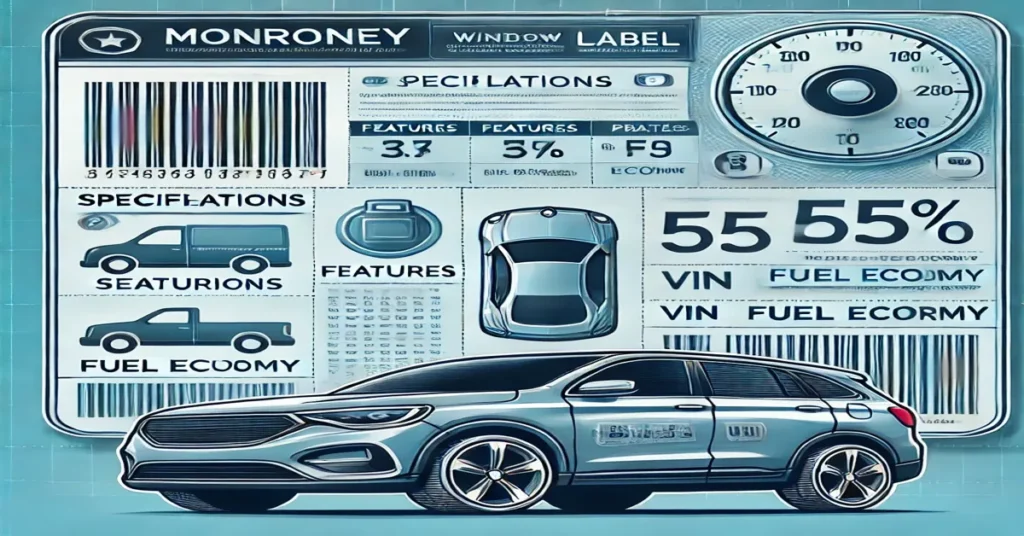A vehicle’s window sticker, often referred to as the Monroney label, is an essential document that provides detailed information about a car’s features, specifications, and pricing. One of the most efficient ways to retrieve a window sticker for a vehicle is by using its Vehicle Identification Number (VIN). This article will provide a comprehensive understanding of what a window sticker is, how it can be accessed using a VIN, and why it is vital for vehicle owners, buyers, and sellers.
What is a Window Sticker?
The window sticker, also known as the Monroney sticker, is a legal requirement in the United States for all new vehicles sold at dealerships. It was named after Senator Almer Stillwell “Mike” Monroney, who sponsored the Automobile Information Disclosure Act of 1958. This act mandates that all manufacturers provide a standardized label affixed to the window of new vehicles, detailing critical information.
The sticker includes information such as:
- Manufacturer Details: Brand, make, model, and manufacturing location.
- Specifications: Engine type, transmission, and other mechanical details.
- Standard and Optional Features: A list of features included in the base model and those added as upgrades.
- Fuel Economy: Miles per gallon (MPG) for city, highway, and combined driving.
- Safety Ratings: Crash test ratings from the National Highway Traffic Safety Administration (NHTSA).
- Warranty Information: Details on manufacturer warranties and service agreements.
- Pricing: Manufacturer’s Suggested Retail Price (MSRP), optional equipment costs, and destination charges.
Why is the Window Sticker Important?
The window sticker serves several critical purposes:
- Transparency: It ensures buyers have access to accurate and consistent information about a vehicle.
- Comparison: Buyers can easily compare features and pricing between different models.
- Resale Value: For used vehicles, having a copy of the original window sticker helps sellers establish credibility and justifies the pricing.
- Ownership Insight: It provides clarity about the vehicle’s original specifications and features, which can be helpful for maintenance or upgrades.
What is a VIN?
A Vehicle Identification Number (VIN) is a unique 17-character alphanumeric code assigned to every vehicle. Think of it as the car’s fingerprint. Each VIN is distinct and provides essential information about the vehicle, such as:
- Manufacturer
- Year of manufacture
- Model and trim level
- Engine type
- Assembly plant location
- Serial number
The VIN can typically be found:
- On the dashboard, visible through the windshield.
- Inside the driver’s side door frame.
- On vehicle registration and insurance documents.
Retrieving a Window Sticker Using a VIN
Accessing a window sticker using the VIN is a straightforward process. There are several ways to do this:
1. Manufacturer Websites
Many automakers offer online tools that allow users to input a VIN and retrieve the original window sticker. For example:
- Ford: Provides a detailed breakdown of the vehicle’s features and options.
- Honda: Offers a similar service for newer models.
2. Third-Party Services
Numerous online platforms specialize in generating window stickers based on VINs. These services often provide:
- A replica of the original sticker.
- Additional details, such as recalls or service history.
Some popular platforms include:
- MonroneyLabels.com
- VIN-specific window sticker lookup tools.
3. Dealerships
If the above options are unavailable, contacting the dealership where the car was purchased or serviced can help. Dealerships often have access to the vehicle’s records and can provide a copy of the sticker.
4. Manufacturer Customer Support
If online tools or third-party services are unavailable, contacting the manufacturer’s customer support line is another reliable option. Provide the VIN, and they can often email or mail a copy of the window sticker.
What Information Does a VIN-Based Window Sticker Provide?
A VIN-based window sticker will provide all the details available on the original sticker, including:
1. Vehicle Specifications
The sticker lists details like:
- Engine size and type.
- Transmission type (manual, automatic, or CVT).
- Drivetrain (FWD, RWD, AWD).
2. Standard Features
The Monroney label outlines features included in the base price of the vehicle, such as:
- Airbags and safety systems.
- Infotainment systems.
- Interior materials and finishes.
3. Optional Features
These are features added beyond the base model, which may include:
- Premium sound systems.
- Sunroof or panoramic roofs.
- Advanced safety systems like adaptive cruise control.
4. Fuel Economy
Fuel efficiency ratings are prominently displayed, helping buyers understand the vehicle’s environmental and cost impact.
5. Pricing
- Base MSRP: The starting price of the vehicle without any optional features.
- Optional Equipment Costs: The cost of added features or packages.
- Destination Charges: Shipping costs for delivering the vehicle to the dealership.
- Total MSRP: The sum of all the above.
Benefits of Retrieving a Window Sticker by VIN
Using a VIN to access a window sticker has several advantages:
1. Accuracy
Since the VIN is unique to each vehicle, it ensures that the retrieved window sticker is specific to the car in question.
2. Detailed History
The window sticker provides a snapshot of the car when it was first sold, which can be invaluable for understanding its history and features.
3. Negotiation Tool
For used car buyers, having a window sticker helps verify the features and specifications the seller claims, ensuring fair negotiations.
4. Compliance
For imported vehicles or those with aftermarket modifications, the original window sticker can help verify compliance with safety and emissions standards.
Limitations and Challenges
While retrieving a window sticker by VIN is generally straightforward, some challenges may arise:
- Older Vehicles For cars manufactured before the widespread use of digital tools, accessing the original window sticker may require manual requests or detailed searches.
- Third-Party Costs Some online services charge a fee for generating VIN-based window stickers.
- Unavailable Records In rare cases, manufacturers or dealerships may not have access to the original sticker, especially for vehicles that have undergone significant modifications.
Frequently Asked Questions (FAQs)
1. Can I retrieve a window sticker for a used car?
Yes, you can retrieve a window sticker for a used car by using the VIN. Many third-party services and manufacturer tools allow you to access this information.
2. Is retrieving a window sticker by VIN free?
While some manufacturer websites provide this service for free, third-party platforms may charge a fee for generating window stickers.
3. Why do dealerships remove window stickers?
Dealerships often remove window stickers after selling the vehicle to prevent confusion for new buyers. However, a copy of the sticker is usually retained in their records.
4. Can I use the window sticker for insurance purposes?
Yes, the window sticker is helpful for insurance purposes as it provides a detailed list of features and specifications, which can affect the premium.
5. What if I cannot find my VIN?
The VIN can be found on the dashboard, driver’s side door frame, or vehicle documents like the registration or insurance.
6. Does the window sticker show service history?
No, the window sticker does not include service history. For service records, you’ll need to check with dealerships or access maintenance logs separately.
By understanding how to retrieve and utilize a window sticker through the VIN, vehicle buyers and owners can make informed decisions, ensuring transparency and confidence in their transactions.







